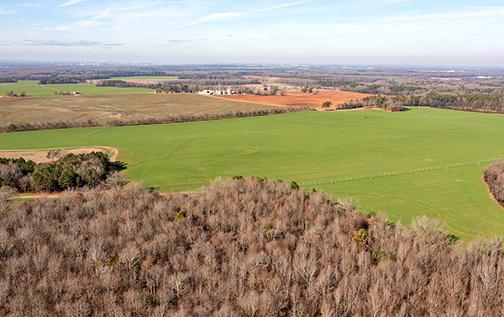Understanding foreign investment in U.S. ag lands
Foreign investment in the United States, while not a new phenomenon, has recently caught the attention of the American public and members of the U.S. House and Senate after an Air Force officer raised concerns when the Fufeng Group, based in Shandong, China, purchased 300 acres of farmland 12 miles from an Air Force base in Grand Forks, North Dakota, to build a corn milling plant (Javers, 2022). National security concerns prompted the U.S. Senate to propose a bill prohibiting the purchase of land in the U.S. by companies or individuals from China, North Korea, Iran, or Russia.
How prevalent is foreign investment?
The foreign direct investment in the U.S. (businesses and land) was $5.25 trillion at the close of 2022. This was an increase of $216.8 billion from 2021. Much of this investment was from companies and individuals from Europe, followed by Asia and Pacific Islands, Canada, Latin America, the Middle East, and Africa. The top investing country was Japan ($775.2 billion), followed by Canada ($683.8 billion) and the United Kingdon ($660.6 billion). Foreign direct investment in the U.S. has been concentrated in the manufacturing industry, with investment in the financial, insurance, and wholesale trade industries also noteworthy (U.S. Bureau of Economic Analysis, 2023).
U.S. initiatives promoting foreign investment
Under the U.S. Department of Commerce, the U.S. promotes job-creating U.S. business investment to foreign, as well as domestic, investors through the SelectUSA program (SelectUSA, 2023). This program has been in existence since 2011 and was preceded by the Invest in America program. In their recent 2023 Investment Summit, nearly 2,300 international delegates participated, including 100 businesses from China (Flannery, 2023)
Understanding the scale of foreign investment
Foreign investment in the U.S. at the end of 2022 was surpassed by the $6.58 trillion invested by U.S. companies and individuals in other countries (U.S. Bureau of Economic Analysis, 2023), including ownership of over 9 million acres in other countries (Lutz, 2021). The countries of interest targeted by these investment dollars generally mirrors those that are investing in the U.S.
The Agricultural Foreign Investment Disclosure Act of 1973 (AFIDA) established a mandatory reporting system overseen by the USDA, requiring foreign entities to complete an information form for all agricultural land purchased or leased (10-year minimum lease) within the United States. According to the most recent AFIDA report, almost 41 million acres of agricultural land in the U.S. is fully or partially owned by foreign entities (USDA/FSA). This amounts to 3.1 percent of total U.S. agricultural land (Foreign Ownership and Holdings of U.S. Agricultural Land, 2023).
Canadian entities own the most land (>9 million acres), followed by investors from the Netherlands, Italy, and the United Kingdom (Figure 2). Chinese entities rank 18th on this list at 194,772 acres. Most of the land under Chinese title is located in North Carolina and Missouri and is owned by the largest pork processer in the U.S., Smithfield, which was purchased by Shuanghui International in 2013 (Foreign Ownership and Holdings of U.S. Agricultural Land, 2023). Almost 2.5 million acres are not appropriately identified in the reporting system, which is a concern for many national lawmakers as they are not sure who holds ownership of that land.
Almost 47 percent of agricultural land owned or leased by individuals or investors from foreign countries is forest land, with just under 29 percent in cropland and 17.8 percent in pastureland (Figure 3). Approximately 4.5 percent is considered other agricultural land and 2 percent other nonagricultural land, which includes roads and homesteads. A large portion of the forest land is owned by Canadian companies for the harvesting of timber.
Why do foreign entities invest in U.S. agricultural land?
Foreign companies and investors invest in business in the U.S. for several reasons, with most centering on the profit motive. First, the U.S. has the world’s largest consumer market along with, perhaps, the world’s best export platform that makes exporting products to other countries less complicated. Second, the business environment in the U.S. is enhanced by access to capital and natural resources, an educated workforce, a stable democracy, transparent and predictable legal system, and product innovation (Flannery, 2023).
Another motivator is our federal incentive programs. While foreign investors are not allowed to participate in certain disaster assistance programs, along with a few other programs administered by the USDA, they are allowed to participate in most farm programs if they meet the general criteria. However, recent legislation has been introduced that would restrict foreign persons from participating in specified programs administered by the USDA (Foreign Ownership and Holdings of U.S. Agricultural Land, 2023).
A major incentive for the purchase or lease of agricultural lands by foreign entities has been the various clean-energy incentives. For example, the Inflation Reduction Act provides incentives for clean-energy projects such as solar farms and battery manufacturing, of which, foreign investors with projects in the U.S. are eligible (Dvorak, 2023). Venesky (2023) noted that a large number of foreign investors purchasing agricultural lands have wind or solar in their company title and are thus suspected of purchasing or leasing many of their agricultural lands for clean energy generation.
Pros and cons of foreign investment in U.S. ag land
While foreign investment adds to economic development in the U.S. and has reduced imports from some foreign countries who have established manufacturing facilities in the U.S., there are downsides to foreign investment. Many are concerned with the erosion of national security, the theft of technology, the potential for intelligence gathering, and the possible foreign control of the U.S. food and energy supply. Competition for land and other natural resources has proven to be a concern in some areas. Another concern is the potential impact on agricultural land values and lease rates. The USDA recently examined changes in agricultural land values and land rental rates across counties with varying levels of foreign ownership between 2012 and 2017 (Foreign Ownership and Holdings of U.S. Agricultural Land, 2023). Their results indicated there were no statistical differences in agricultural land values or rental rates based on the level of foreign investment in each county.
While there are several reasons to be concerned about foreign ownership of U.S. resources, the major concern appears to be when foreign entities from countries that are in conflict with the U.S. obtain ownership of U.S. capital assets. The relatively small percentage of U.S. agricultural lands owned or leased by foreign entities will most likely continue to grow as individuals and companies from foreign countries seek to further their investments in the U.S.
Watch the webinar recording: Foreign Investment in the U.S. and Ag Land Ownership Restrictions (Sept. 28, 2023)
This article was written by Larry Van Tassell, Professor and Director, Center for Agricultural Profitability at the University of Nebraska-Lincoln.





